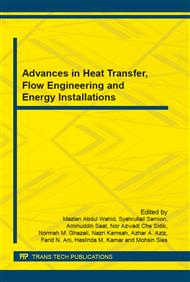[1]
Michael V. Albanese, Brian S. Robinson, Ellen G. Brehob, M. Keith Sharp, Simulated and Experimental Performance of A Heat pipe Assisted Solar Wall, Solar Energy 86 (2012) 1552-1562.
DOI: 10.1016/j.solener.2012.02.017
Google Scholar
[2]
Indonesia energy outlook & statistic 2006. Depok, Indonesia: Energy Reviewer, University of Indonesia; (2006).
Google Scholar
[3]
M. Hammad, Experimental Study of The Performance of A Solar Collector Cooled By Heat pipes, Energy Convers. Mgmt, Vol. 36, No. 3, (1995), pp.197-203.
DOI: 10.1016/0196-8904(94)00050-a
Google Scholar
[4]
Vasiliev Leonard L., Review Heat pipes in Modern Heat Exchangers, Applied ThermaL Engineering 25 (2005) 1-19.
DOI: 10.1016/j.applthermaleng.2003.12.004
Google Scholar
[5]
R. Kempers, A.J. Robinson, D. Ewing, C.Y. Ching, Characterization of evaporator and condenser thermal resistances of a screen mesh wicked heat pipe, International Journal of Heat and Mass Transfer 51 (2008) 6039-6046.
DOI: 10.1016/j.ijheatmasstransfer.2008.04.001
Google Scholar
[6]
Kyu Hyung Do, Hyo Jun Ha, Seok Pil Jang, Thermal Resistance of Screen Mesh Wick Heat pipes Using The Water-based Al2O3 Nanofluids, International Journal of Heat and Mass Transfer 53 (2010) 5888-5894.
DOI: 10.1016/j.ijheatmasstransfer.2010.07.050
Google Scholar
[7]
Shoeib Mahjoub, Ali Mahtabroshan, Numerical Simulation of A Conventional Heat pipe, Word Academy of Science : Engineering and Technology 39 (2008) 117-122.
Google Scholar
[8]
W. W Wits, R. Legtenberg, J. H Manna, Selecting Capilary Structures forHeat pipe in Multilayer Printed Circuit Boards, European Thermal-Science, The Netherlands (2008).
Google Scholar
[9]
M. Raisul Islam, K. Sumathy, Samee Ullah Khan, Solar Water Heating Systems and Their Trend Markets, Renewable and Sustainable Energy Reviews 17 (2013) 1-25.
DOI: 10.1016/j.rser.2012.09.011
Google Scholar
[10]
Yong Li, Heng-fei He, Zhi-xin Zeng, Evaporation and Condensation Heat Transfer in A Heat pipe with A Sintered-Grooved Composite Wick, Applied Thermal Engineering 50 (2013) 342-351.
DOI: 10.1016/j.applthermaleng.2012.07.042
Google Scholar
[11]
Nchelatebe Nkwetta, Mervyn Smyth, Performance analysis and comparison of concentrated evacuated tube heat pipe solar collectors, Applied Energy 98 (2012) 22-32.
DOI: 10.1016/j.apenergy.2012.02.059
Google Scholar
[12]
David A.G. Redpath, Thermosyphon Heat-pipe Evacuated Tube Solar Water Heaters for Northern Maritime Climates, Solar Energy 86 (2012) 705-712.
DOI: 10.1016/j.solener.2011.11.015
Google Scholar
[13]
David A.G. Redpath, Philip C. Eames, Steve N.G. Lo, Phillip W. Griffiths, Experimental investigation of natural convection heat exchange within a physical model of the manifold chamber of a thermosyphon heat-pipe evacuated tube solar water heater, Solar Energy 83 (2009).
DOI: 10.1016/j.solener.2009.01.002
Google Scholar
[14]
H.M.S. Hussein, H.H. El-Ghetany, S.A. Nada, Performance of wickless heat pipe flat plate solar collectors having different pipes cross sections geometries and filling ratios, Energy Conversion and Management 47 (2006) 1539-1549.
DOI: 10.1016/j.enconman.2005.08.009
Google Scholar
[15]
H.M.S. Hussein, M.A. Mohamada, A.S. El-Asfourib, Optimization of a wickless heat pipe flat plate solar collector, Energy Conversion and Management 40 (1999) 1949-(1966).
DOI: 10.1016/s0196-8904(99)00082-5
Google Scholar
[16]
S.J. Munusamy, Heat Pipes in Electronic Packaging [TJ264. S774 2007 frb], Universiti Sains Malaysia, (2006).
Google Scholar
[16]
F.J. Hong, P. Cheng, H.Y. Wu, Z. Sun, Evaporation/Boiling Heat Transfer on Capillary Feed Copper Particle Sintered Porous Wick at Reduced Pressure, International Journal of Heat and Mass Transfer 63 (2013) 389-400.
DOI: 10.1016/j.ijheatmasstransfer.2013.03.086
Google Scholar


